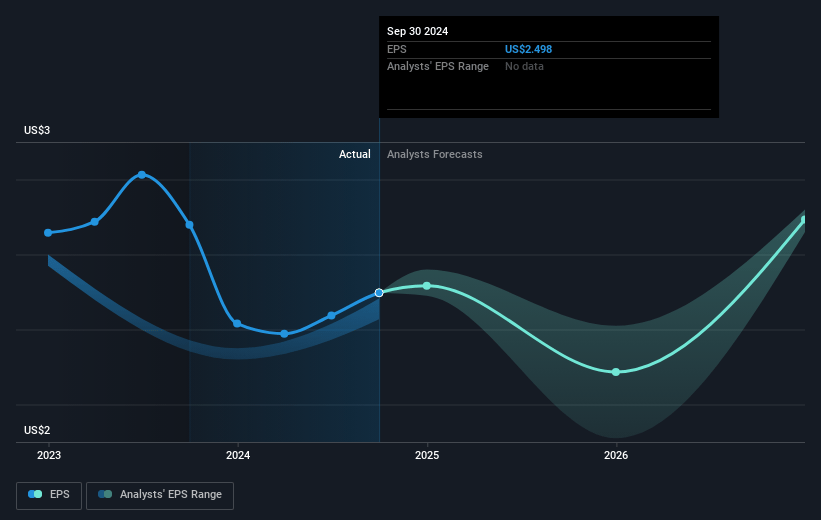Narratives are currently in beta
Key Takeaways
- Growth in wealth management and insurance boosts potential for higher revenues, alongside a focus on improving net margins through cost control.
- Share buybacks and strategic liquidity management aim to enhance earnings per share and optimize returns.
- Intense competition and economic factors may pressure Univest Financial's margins and profitability, with challenges in deposit pricing, loan competition, and liquidity management.
Catalysts
About Univest Financial- Operates as the bank holding company for Univest Bank and Trust Co.
- Univest Financial's commitment to expanding noninterest income through growth in wealth management and insurance lines of business, which increased by 9.8% and 8% respectively, indicates potential for higher future revenues.
- The company's active expense management and reduction of noninterest expenses by $436,000 or 0.9% year-over-year suggest opportunities to increase net margins by maintaining cost control.
- The ongoing share repurchase program, with 1 million shares newly approved for buybacks, is likely to enhance earnings per share (EPS), supporting future earnings growth.
- Anticipated stabilization and eventual increase in core net interest margin (NIM) in response to potential Federal Reserve rate cuts suggests potential improvement in net interest income.
- Strategic use of excess liquidity and excess capital in balance sheet optimization indicates potential for higher returns and impact on net margins and earnings.
Univest Financial Future Earnings and Revenue Growth
Assumptions
How have these above catalysts been quantified?- Analysts are assuming Univest Financial's revenue will grow by 5.7% annually over the next 3 years.
- Analysts assume that profit margins will shrink from 25.4% today to 22.2% in 3 years time.
- Analysts expect earnings to reach $75.4 million (and earnings per share of $2.65) by about November 2027, up from $73.2 million today.
- In order for the above numbers to justify the analysts price target, the company would need to trade at a PE ratio of 12.5x on those 2027 earnings, up from 12.2x today. This future PE is lower than the current PE for the US Banks industry at 12.8x.
- Analysts expect the number of shares outstanding to decline by 0.65% per year for the next 3 years.
- To value all of this in today's terms, we will use a discount rate of 6.04%, as per the Simply Wall St company report.
Univest Financial Future Earnings Per Share Growth
Risks
What could happen that would invalidate this narrative?- Univest Financial anticipates a contraction in net interest income of 4% to 5% for 2024, which could pressure overall profitability despite loan growth projections, directly impacting earnings.
- The competitive environment for deposit pricing remains intense, which may constrain net interest margins if deposit costs do not decrease in concert with expected Fed rate cuts, potentially impacting net margins.
- The provision for credit losses guidance is reduced yet remains subject to event-driven factors, such as economic changes or specific credit issues, which could create volatility in the company's earnings.
- A significant portion of Univest’s deposits is subject to seasonal fluctuations, notably in public funds, which might introduce liquidity management challenges and potentially affect revenue consistency.
- Competition for loans remains stiff, with observed tighter spreads on larger credits, which could erode net interest margins if loan pricing does not adequately compensate for the associated risks.
Valuation
How have all the factors above been brought together to estimate a fair value?- The analysts have a consensus price target of $28.17 for Univest Financial based on their expectations of its future earnings growth, profit margins and other risk factors.
- In order for you to agree with the analyst's consensus, you'd need to believe that by 2027, revenues will be $340.5 million, earnings will come to $75.4 million, and it would be trading on a PE ratio of 12.5x, assuming you use a discount rate of 6.0%.
- Given the current share price of $30.71, the analyst's price target of $28.17 is 9.0% lower. The relatively low difference between the current share price and the analyst consensus price target indicates that they believe on average, the company is fairly priced.
- We always encourage you to reach your own conclusions though. So sense check these analyst numbers against your own assumptions and expectations based on your understanding of the business and what you believe is probable.
How well do narratives help inform your perspective?
Disclaimer
Warren A.I. is a tool utilizing a Large Language Model (LLM) that ingests data on consensus price targets, forecasted revenue and earnings figures, as well as the transcripts of earnings calls to produce qualitative analysis. The narratives produced by Warren A.I. are general in nature and are based solely on analyst data and publicly-available material published by the respective companies. These scenarios are not indicative of the company's future performance and are exploratory in nature. Simply Wall St has no position in the company(s) mentioned. The price targets and estimates used are consensus data, and do not constitute a recommendation to buy or sell any stock, and they do not take account of your objectives, or your financial situation. Note that Warren A.I.'s analysis may not factor in the latest price-sensitive company announcements or qualitative material.
Read more narratives
There are no other narratives for this company.
View all narratives



